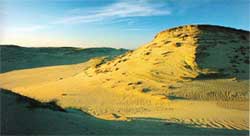About Lithuania
| Oficial Name | Lietuvos Respublika (Republic of Lithuania) |
| Population | 3 500 000 (2001 m.) |
| Area | 65 301 km2 |
| Capital | Vilnius |
| Official language | Lithuanian |
| Religion | Roman Catholic |
| Currency | 1 Euro |
| National day | 16 February |
Lithuania is the southernmost of the Baltic countries. It is bounded on the north by Latvia, on the east and southeast by Belarus, and on the southwest by the Russian Kaliningrad area and by Poland. The hills in the extreme east of the country give way to the flat expanses of the central lowlands, rounded off by a long belt of sand dunes along Baltic coast. Peoples of the Baltic settled in present-day Lithuania from the 7th to the 2nd century BC. Lithuania was united by Mindaugas in 1236, and seventeen years later Mindaugas was crowned the first king of Lithuania. Lithuania was able to withstand attacks from the Teutonic Knights and entered into a personal union with Poland instead 1385. Al this time the Lithuanians also converted to Christianity, the last people in Europe to do so. Under the rule of Grand Duke Vytautas the Great, Lithuania had by the beginning of the 1400s become one of the most powerful countries in all of Europe and had expanded as far as the Black Sea. Polish domination increased until 1795, when the country was incorporated into tsarist Russia. Lithuania declared independence in 1918, but in 1920 Polish forces occupied the Vilnius area and in the period between the two world wars the capital was changed to Kaunas.
 Independence was to last until 1940, when Lithuania was annexed by the Soviet Union. Nazi Germany invaded in 1941, and 90 per cent of Lithuania’s 250 000 Jews were killed during the occupation.
Independence was to last until 1940, when Lithuania was annexed by the Soviet Union. Nazi Germany invaded in 1941, and 90 per cent of Lithuania’s 250 000 Jews were killed during the occupation.

Soviet forces then recaptured Lithuania in 1944 and around 700 000 Lithuanians were either deported to Siberia, forced into exile, imprisoned or shot. In 1990, Lithuania was the first Baltic country to once again declare independence. On “Bloody Sunday”, 13 January the following year, 14 unarmed civilians were killed by Soviet internal forces in Vilnius. It was to be August 1991 before Lithuania finally regained its independence.
Lithuania is a republic, but the constitution confers greater authority on the president then that enjoyed by the presidents of Estonia or Latvia. The Lithuanians national assembly – Seimas – has 141 members.
The Lithuanians economy is showing a positive trend. Inflation is down to 13 per cent (1996), the exchange rate is stable, foreign investment has increased and industry is showing signs of growth.
Like the other Baltic countries, Lithuania has a strong tradition of popular culture, especially in music, choir singing and folklore.
TRANSPORT CONNECTIONS
By Air
There are three international airports in Lithuania – in Vilnius, Kaunas, Palanga. Flying to Lithuania is also possible trough neighbouring countries combining types, ways and means of transportation.
By Sea
The port of Klaipeda, being ice-free all year round, is the biggest in the Baltics. There are 6 regular ferry lines of passengers and cargoes. You can travel by car, coach or train from Klaipeda to bigger cities of Lithuania and the Baltic States.
By Road
Roads in Lithuania are considered to be the best in the Baltic States. The via Baltica motorway connecting Helsinki with Warsaw and running trough three Baltic States is under construction. There is a well-developed domestic and international bus network in Lithuania and they are popular and quite comfortable.
You can also reach Lithuania by railway.
